Introduction for Common Instruments and their uses:
For GNM second-year students, understanding common instruments and their uses is a key milestone in nursing education. These instruments are vital for ensuring precision and safety during surgical procedures, and mastering their applications is essential for both academic success and clinical practice. This guide is specially crafted to meet the curriculum requirements of WBNC, providing detailed insights into frequently used OT instruments, their uses, contraindications, and sterilization methods. With this resource, you’ll be better prepared to excel in your exams and practical training.
Here are some common OT instruments listed:
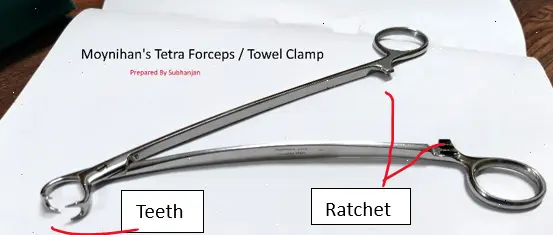
Moynihan’s Tetra forceps / Towel Clamp
Uses
- Securing Surgical Drapes: The primary use is to fix surgical drapes in place, ensuring that the operative field remains sterile and uncontaminated.
- Teeth Ratchet Grasping Tissue: It can be used to hold and manipulate tissues during surgical procedures.
- Clamping: The clip can act as a temporary clamp for small blood vessels or tissues.
- Retraction: Sometimes used to retract tissues and provide better visibility and access Contraindications
- Delicate or Fragile Tissues, Infected or Inflamed Areas, Sensitive Organs: such as nerves, blood vessels, or the gastrointestinal tract.
- Situations Requiring Atraumatic Handling.
Treatment and Care : Sterilization: Boiling half an hour / autoclaving.
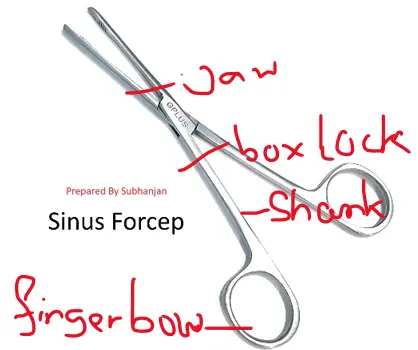
Sinus Tissue Forceps
Uses:
- Nasal Surgery: Used for removing diseased tissue or foreign bodies from the nasal and sinus cavities. Draining and dressing an abscess cavity, releasing hematoma, placing drain in sinus
- Polyp Removal
- Biopsy: Can be used to take tissue samples from nasal or sinus cavities for diagnostic purposes.
- Foreign Body Retrieval: Used to retrieve foreign objects lodged in the nasal or sinus cavities.
- Tissue Manipulation: Assists in manipulating and dissecting tissue within the nasal cavity during various ENT procedures.
Contraindications
Infection: Should not be used if there is an active infection in the nasal or sinus cavities to prevent further spread. Severe Bleeding Disorders: Patients with severe coagulopathies may not be suitable candidates due to the risk of excessive bleeding. Acute Trauma: Avoid in cases of acute nasal trauma where the structural integrity of nasal passages is compromised. Anatomical Abnormalities: Extreme caution or alternative tools may be needed in patients with significant anatomical abnormalities that increase the risk of injury.
Recent Surgery: Not recommended immediately following nasal or sinus surgery to allow healing.
Treatment and Care: Cleaning with enzymatic cleaner, disinfection with disinfectant and boiling / autoclaving.
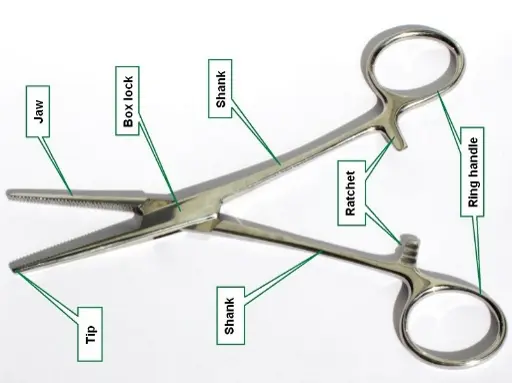
ARTERY FORCEPS
USES:
To catch bleeders, to open an abscess cavity by Hilton’s method in absence of sinus forceps, To crush base of appendix during appendicectomy, in absence of appendix clamp. May be used as dressing forceps, hold peritoneal margins during explorations and closure of abdomen. Hold one end of suture material during a continuous suture. May be used to hold needle in absence of needle holder. May be used as blunt dissector.
Contraindications: Fragile Tissues, Infected Areas Arterial Clamping: Should not be used on large arteries for a prolonged period as they may cause tissue damage or necrosis. Treatment and Care: Autoclaving Chemical Sterilization: chemical sterilants like ethylene oxide or glutaraldehyde can be used: Dry Heat Sterilization 160-180°C (320-356°F) for 2 hours Cold Sterilization: Submerge the forceps in a cold sterilant solution, such as hydrogen peroxide or peracetic acid, for the recommended time (usually several hours).
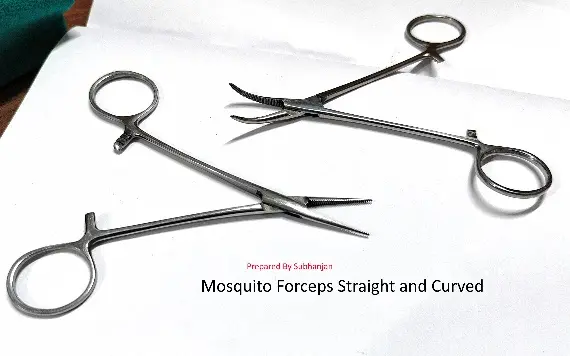
Mosquito Forceps:
Uses of Mosquito Forceps:
Used to catch hold of very fine bleeding points e.g. During repair of cleft lip and cleft palate. During operation of circumcision. Grasping and holding delicate tissues. Dissect fine tissues, especially in precise or minimally invasive surgeries.
Remove foreign objects, Hold sutures.
Contraindication:
Clamp large blood vessels, heavy tissues, manipulating bone/ hard structures, Infected tissue. Treatment and care: same as artery forceps.
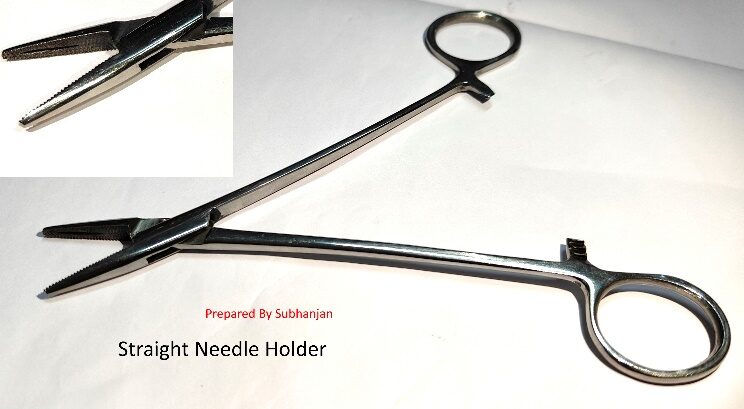
Straight Needle Holder
Uses of Straight Needle Holder:
To hold a suturing needle for closing wounds during suturing and surgical procedures.
Contraindications:
Tissue Fragility: In cases where tissues are extremely fragile or delicate, using a needle holder might cause additional trauma or damage. Small Surgical Fields: In very narrow or confined surgical fields, the bulkiness of the needle holder may obstruct the view or hinder access.
Treatment and care: same as artery forceps.

Allis Tissue Forceps
Uses of Allis Tissue Forceps:
Grasping and Holding Thinner structures: Skin, Deep Fascia, Layers of Rectus Sheath, Fibrous capsule of a structure Retracting: They can also be used to retract tissues away from the surgical area to provide better visibility and access for the surgeon. Removing Foreign Objects: Sometimes used to grasp and remove foreign objects from wounds or cavities.
Contraindications: Fragile Tissues: Not recommended for use on delicate or easily damaged tissues, such as blood vessels or nerves, due to the risk of crushing or tearing. Infected or Inflammatory Tissues: Avoid using Allis forceps on tissues that are infected or inflamed, as the teeth can cause additional trauma and exacerbate the condition. Treatment and care: same as artery forceps.
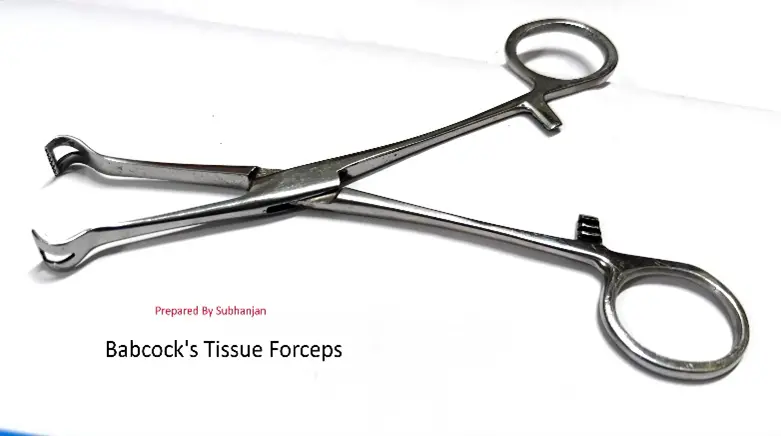
Babcock’s Tissue Forceps
Uses of Babcock’s Tissue Forceps:
Holding soft tissues and delicate structures such as to hold the appendix during appendicectomy, stomach or intestine during gastrojejunostomy, intestines, bladder. Gynaecological Surgery: Often used to grasp and manipulate the uterus, ovaries, or fallopian tubes during procedures like hysterectomies or tubal ligations. Gastrointestinal Surgery: To handle sections of the bowel without causing trauma. Urological Procedures: For grasping delicate structures within the urinary tract.
Contraindications: Fragile or Compromised Tissue: Should not be used on tissues that are extremely fragile or severely compromised, as even gentle handling could cause damage. Dense or Fibrous Tissue: Not suitable for grasping dense or fibrous tissues which might require a more robust instrument. Infected Tissue: Caution should be taken when dealing with infected tissues to avoid spreading infection. Treatment and care: same as artery forceps.
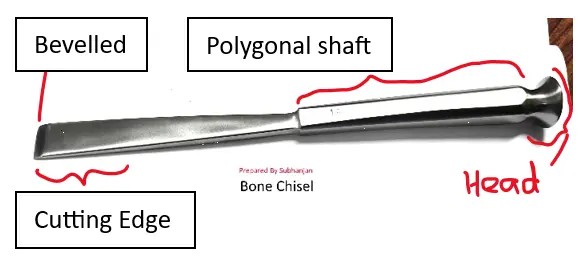
Bone Chisel
Uses of Bone Chisel:
Used to remove bone chips in operations like sequestrectomy, Bone grafting or S.P. nailing.
Orthopaedic Surgery: Shaping and sculpting bone. Removing bone spurs or other bony growths. Cutting or splitting bones during osteotomies. Dental Surgery: Reshaping the jawbone during dental implant procedures. Removing bone to allow for the extraction of impacted teeth. Performing alveoloplasty to smooth and reshape the jawbone. Neurosurgery: Performing craniotomies (removing a portion of the skull to access the brain).
Contraindications: Infection at the Surgical Site, Compromised Bone Integrity, Coagulation Disorders
Treatment and care: same as artery forceps.

Rampley’s Sponge Holding Forceps
Uses of Rampley’s Sponge Holding Forceps:
Antiseptic dressing before operations, for swabbing a body cavity, to facilitate dissection and mild retraction at depth, as tongue holding forceps, may be used as ovum holding forceps. Contraindications: Allergy to Materials: If the patient is allergic to the materials from which the forceps are made (commonly stainless steel). Inappropriate Use: Using these forceps for tasks they are not designed for, such as handling heavy or hard tissue, which can cause damage to the instrument or the tissue. Treatment and care: same as artery forceps.
Dissecting Forceps:

| Uses of Toothed Dissecting Forceps: Toothed dissecting forceps have small, sharp teeth on the ends of their jaws that help grip tissues firmly. Dissection: They are commonly used in various surgical procedures for precise dissection and manipulation of tissues. Hemostasis: They can be used to control bleeding by grasping and compressing blood vessels. Contraindications: Cannot be used to hold soft friable tissue. Typically avoided in neurosurgery where delicate tissue handling is crucial to prevent trauma. Treatment and care: same as artery forceps. | Uses of Non-Toothed Dissecting Forceps: also known as atraumatic forceps, Handling Delicate Tissues: Ideal for manipulating delicate tissues such as blood vessels, nerves, or thin membranes where minimal trauma is crucial. Suturing: Commonly used in suturing to hold tissues together while sutures are being placed. Dressing Changes: Useful in changing dressings and handling surgical materials without damaging them. Biopsies: Employed in holding tissue during biopsy procedures. Contraindications: Thick or Tough Tissues, Heavy Lifting, High Tension Areas |

B.P. Handle
Uses of B.P. Handle:
The Bard-Parker handle is primarily used to hold surgical blades. It allows for precise control and manoeuvrability during surgeries.
Contraindication: Patients with known allergies to the materials used in the handle or blade (typically stainless steel) should avoid use. Should not be used if sterility cannot be guaranteed, as this can introduce infections. Treatment and care: same as artery forceps.
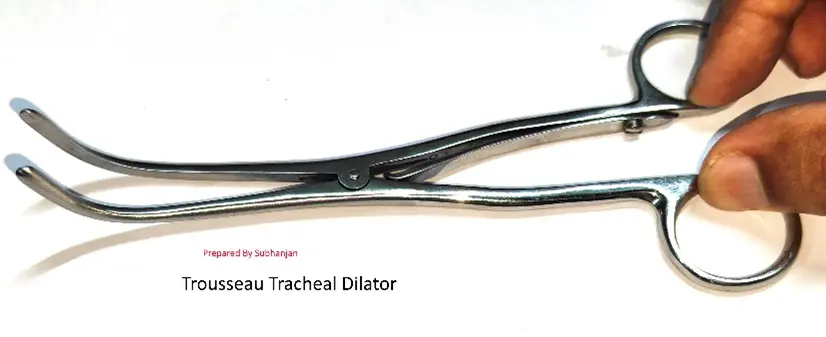
Trousseau Tracheal Dilating Forceps
Uses of Trousseau Tracheal Dilating Forceps:
These forceps are designed to gently dilate the trachea during surgical procedures or when inserting a tracheostomy tube.
Contraindications: Inflammation or Infection: Use of tracheal dilating forceps may be contraindicated in cases of severe tracheal inflammation or infection to avoid exacerbating the condition or spreading the infection. Trauma: Patients with recent trauma to the trachea or surrounding tissues may also be contraindicated due to the risk of further injury or complications. Treatment: autoclave @ 121°C for 15-20 minutes, glutaraldehyde sterilization.
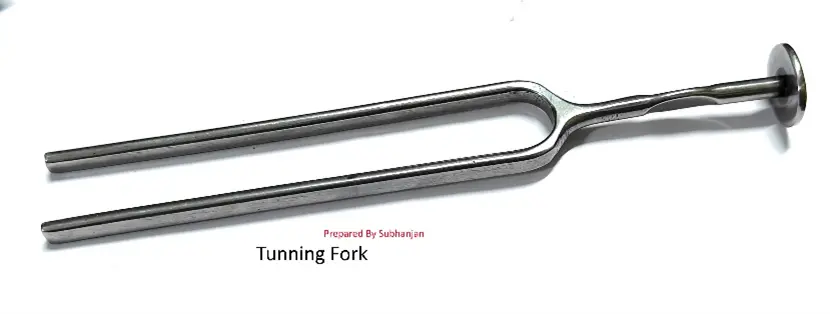
Tunning Fork
Uses of Tunning Fork:
Used for qualitative assessment of deafness. Neurological Examinations: Assessing nerve function by testing sensory perception and vibration sense.
Contraindications: Middle Ear Infections: In cases of active middle ear infections (otitis media), using a tuning fork for hearing tests can be uncomfortable or painful for the patient. External Ear Obstructions: If there are obstructions like wax build up in the external ear canal, accurate hearing tests with a tuning fork may be compromised.
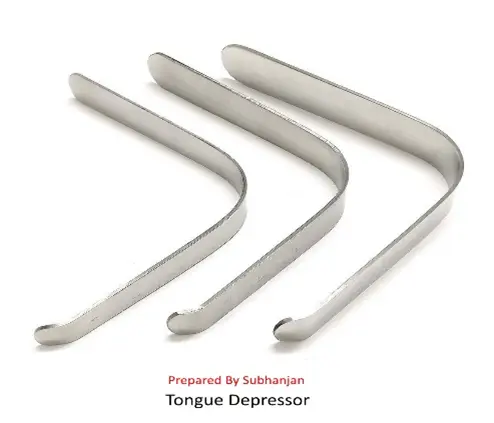
Tongue Depressor
Uses of Tongue Depressor:
Medical Examination: Tongue depressors are essential for medical professionals to inspect the throat and mouth, aiding in diagnosing conditions like strep throat, tonsillitis, or other oral infections. Application of Medications: They are also used to apply topical medications or anaesthetics to the back of the throat or mouth. Assessment of Swallowing Reflex: They can help assess the swallowing reflex and oral motor function in patients with neurological conditions.
For drainage of an acute retropharyngeal abscess.
Contraindications: Hypersensitive gag reflex, Oral Injuries: Patients with severe oral injuries, such as lacerations or burns.
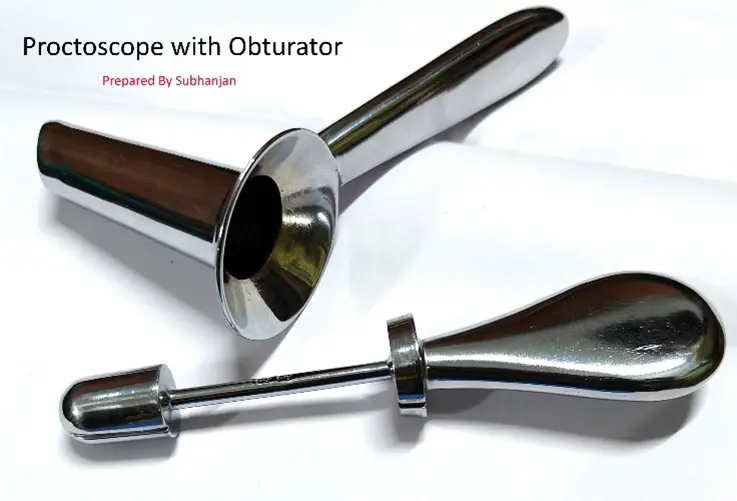
Proctoscope
Proctoscope uses:
· Diagnostic Examination: It allows healthcare providers to visually inspect the anal canal and rectum for abnormalities such as haemorrhoids, fissures, polyps, or tumours. Therapeutic Procedures: Proctoscopes can also be used to perform minor surgical procedures such as banding of haemorrhoids or biopsy of suspicious lesions.
Contraindications: Acute Anal or Rectal Inflammation, Perforation Risk: Patients with a history of rectal or anal surgery, recent trauma, or suspected perforation should avoid proctoscopy examination Coagulation Disorders: Individuals with bleeding disorders or those on anticoagulant therapy may be at increased risk of bleeding during or after proctoscopy procedures.
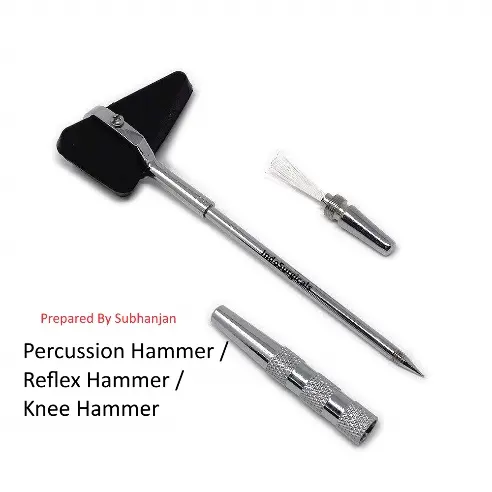
Knee hammer / Percussion Hammer
Uses of knee hammer:
- Testing Reflexes: The primary purpose of a percussion hammer is to elicit and assess deep tendon reflexes. This helps healthcare providers evaluate the functioning of the nervous system and detect abnormalities such as hyperreflexia or hyporeflexia.
- Neurological Examinations: It is an essential tool in neurological examinations to assess reflex arcs and nerve function.
Contraindications:
- Skin Injuries: Do not use the percussion hammer on areas of the skin that are injured or have wounds. This could cause pain or discomfort to the patient.
- Fractures or Injuries: Avoid using the hammer over areas with fractures or recent injuries, as it could exacerbate pain or cause further damage.
- Infections: If the hammer is not properly sterilized between uses, there is a risk of transferring infections from one patient to another.
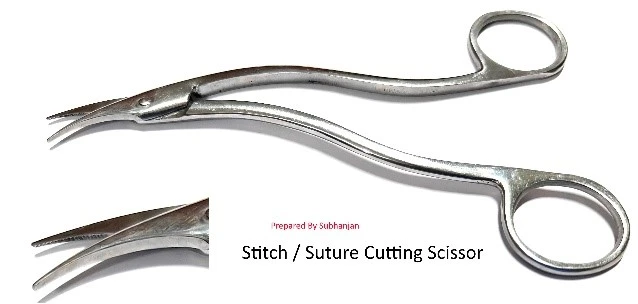
Stitch Cutting scissor
Uses: A stitch cutting scissor is a specialized medical tool used primarily for removing sutures (stitches) from wounds.
Contraindications:
- Infection Risk: Using a stitch cutting scissor on contaminated or infected wounds can potentially spread infection further.
- Poor Healing Wounds: In cases where wounds are not healing well or where there is significant inflammation, using a scissor might aggravate the condition.
- Fragile Skin: Particularly delicate or fragile skin, such as in elderly patients or those with certain skin conditions, may be more prone to damage during suture removal.

Mayo’s towel clip
Uses of Mayo’s towel clip:
- Securing Towels and Drapes: Towel clips are primarily used to secure sterile towels and surgical drapes to the patient’s body or the operating table. This helps maintain a sterile field by preventing contamination.
- Tissue Retraction: In some cases, towel clips may be used for temporary tissue retraction during surgery to improve visibility and access to the surgical site.
Organizing Instruments: They can also be used to organize instruments and maintain order on the surgical tray.
Contraindications:
- Allergic Reactions: Towel clips are typically made of stainless steel or other metals. Patients with known allergies to these materials may experience skin reactions or sensitivities.
- Improper Placement: Incorrect placement or excessive force when securing towels or drapes with towel clips can potentially cause tissue damage, especially if placed too tightly or on delicate areas.
- Specific Surgical Conditions: Certain surgical conditions or procedures may not be compatible with the use of towel clips due to the positioning or nature of the operation. Surgeons must consider the specific requirements of each procedure.
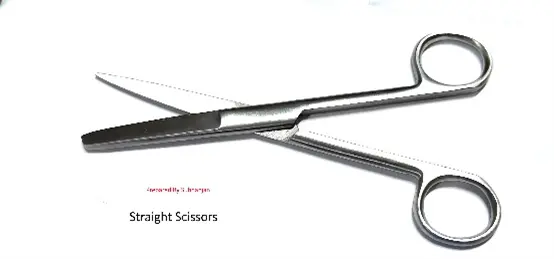
Plain Straight Scissor
Uses of Plain Straight Scissor: Plain scissors are versatile tools used in various medical and surgical procedures. They are primarily employed for cutting bandages, sutures, and dressings.
Contraindications: While plain scissors are useful in many scenarios, they are not suitable for cutting through tougher materials like bone or hard tissue. Attempting to use them for such purposes can damage the scissors or result in inadequate cutting, potentially compromising the procedure’s outcome.
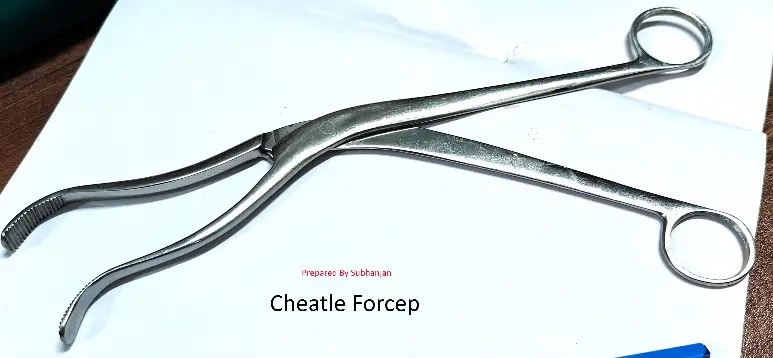
Cheatle Forceps
Uses of Cheatle Forcep:
- Tissue Grasping: Cheatle forceps are commonly used to grasp tissues during surgeries. They provide a firm grip, which helps surgeons manipulate tissues effectively.
- Retraction: They can be used to retract tissues or organs to improve visibility and access during surgical procedures.
Hemostasis: In some cases, Cheatle forceps are used for temporary hemostasis (controlling bleeding) by applying pressure to blood vessels.
Contraindications:
- Delicate Tissues: Due to their strong grip, Cheatle forceps may not be suitable for delicate tissues or structures that could be damaged by excessive pressure or trauma.
- Risk of Crushing: There is a risk of tissue damage or crushing if the forceps are not used carefully, especially on fragile tissues or organs.
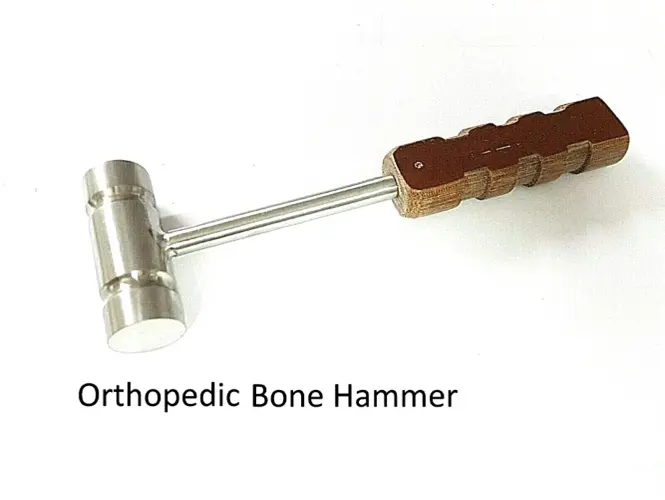
Bone Hammer / Mallet
Uses of Bone Hammer / Mallet:
- A bone hammer, also known as a mallet, is a surgical instrument used in orthopedic and neurosurgical procedures.
- It is primarily used to gently tap implants or instruments into place during surgeries involving bones and joints.
- The hammer’s design typically includes a flat or slightly rounded head made from materials like stainless steel or titanium to minimize damage to bone surfaces.
Contraindications:
- Contraindications refer to conditions or situations where the use of a bone hammer may not be advisable or safe. Some common contraindications include:
- Severe osteoporosis: Bone fragility increases the risk of fractures with even gentle tapping.
- Presence of bone infections: Hammering can spread infection to adjacent tissues or cause dissemination of bacteria.
- Fractures near vital structures: Using a hammer near nerves or blood vessels can lead to injury or complications.
- Certain bone conditions: Conditions like brittle bone disease (osteogenesis imperfecta) or certain tumors may require alternative approaches.
Sterilization:
· Methods of sterilization commonly used include autoclaving (steam under pressure), ethylene oxide gas sterilization, and chemical sterilant.
· Before sterilization, instruments are usually cleaned manually or with automated cleaners to remove organic material and debris.
Conclusion for Common Instruments and their uses:
.As a GNM second-year student, gaining expertise in common instruments and their uses is essential for your nursing journey. This guide has been curated to align with your curriculum, helping you confidently approach surgical nursing. By understanding the applications, contraindications, and sterilization techniques of these tools, you are building a strong foundation for your career. Share this resource with your classmates and revisit it whenever you need a quick reference—it’s your stepping stone to becoming a skilled nursing professional!
Checkout other important posts at https://studentnurse.in/

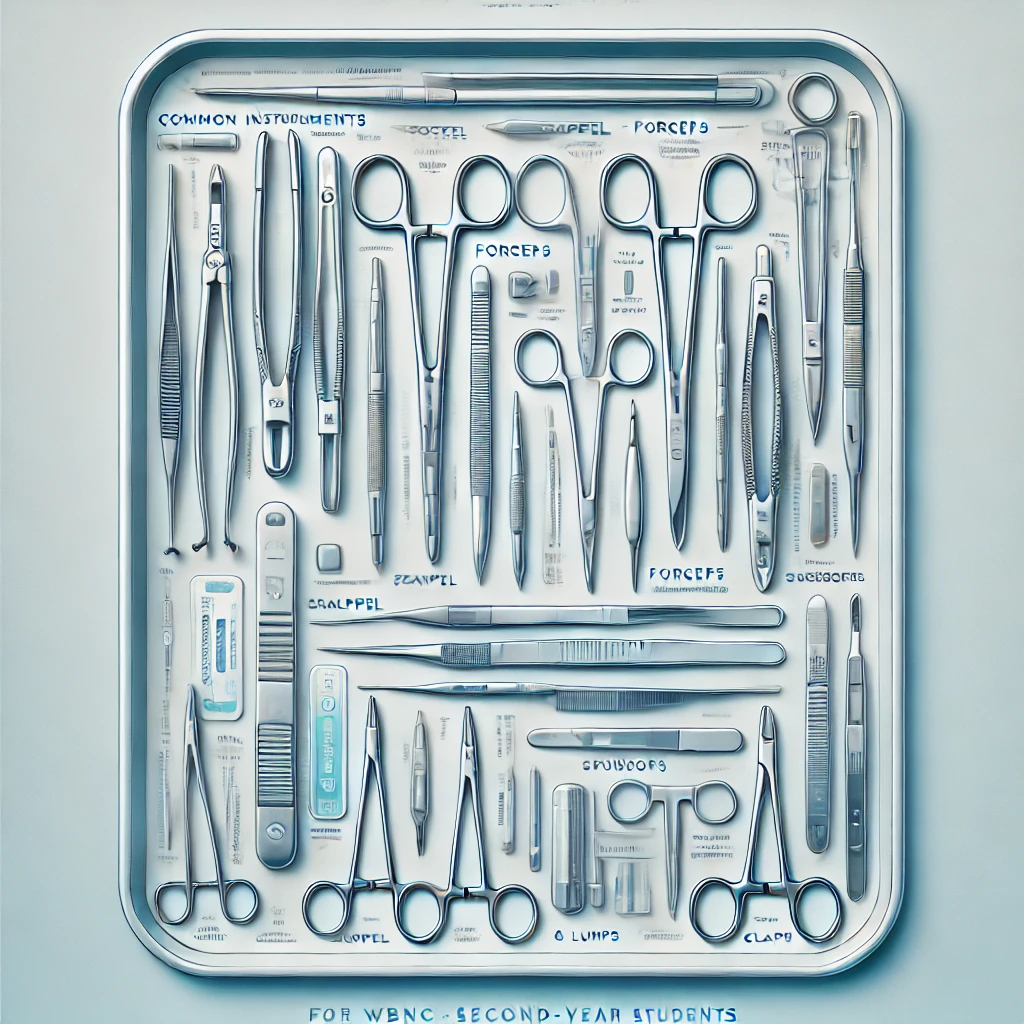

What do you think?
It is nice to know your opinion. Leave a comment.